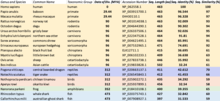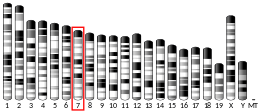Interferon-inducible GTPase 5
Interferon-inducible GTPase 5 also known as immunity-related GTPase cinema 1 (IRGC1) is an enzyme that in humans is coded by the IRGC gene.[5][6] It is predicted to behave like other proteins in the p47-GTPase-like and IRG families. It is most expressed in the testis.[6][7]
| IRGC | |||||||||||||||||||||||||
|---|---|---|---|---|---|---|---|---|---|---|---|---|---|---|---|---|---|---|---|---|---|---|---|---|---|
| Identifiers | |||||||||||||||||||||||||
| Aliases | IRGC, CINEMA, IFGGE, IRGC1, Iigp5, R30953_1, immunity related GTPase cinema | ||||||||||||||||||||||||
| External IDs | MGI: 2685948 HomoloGene: 10486 GeneCards: IRGC | ||||||||||||||||||||||||
| |||||||||||||||||||||||||
| |||||||||||||||||||||||||
| Orthologs | |||||||||||||||||||||||||
| Species | Human | Mouse | |||||||||||||||||||||||
| Entrez | |||||||||||||||||||||||||
| Ensembl | |||||||||||||||||||||||||
| UniProt | |||||||||||||||||||||||||
| RefSeq (mRNA) | |||||||||||||||||||||||||
| RefSeq (protein) |
| ||||||||||||||||||||||||
| Location (UCSC) | Chr 19: 43.72 – 43.72 Mb | Chr 7: 24.43 – 24.45 Mb | |||||||||||||||||||||||
| PubMed search | [3] | [4] | |||||||||||||||||||||||
| Wikidata | |||||||||||||||||||||||||
| |||||||||||||||||||||||||
Gene
IRGC is located on chromosome 19 at position 19q13.31 and contains two exons.[5][8] It is on the forward strand and is upstream of Phospholipase A2 Inhibitor and Ly6/PLAUR Domain-Containing Protein-Like (LOC105372412) and downstream of Nonsense Mediated mRNA Decay Factor (SMG9).[7]
Homology and Evolution
Paralog
There is one paralog for IRGC named IRGM. IRGM, or immunity related GTPase M, is associated with intracellular defense.[9][10] Both are part of the p47-GTPase-like family and the P-loop NTPase domain superfamily. The paralog has 12% identity to IRGC.
Orthologs

IRGC was observed to be conserved in all vertebrates. The GTP/Magnesium and polypeptide binding regions and a transmembrane region are fairly conserved between species.[11]
Evolution

IRGC is predicted to have evolved more rapidly than cytochrome c and β-hemoglobin when comparing the percent identity of the same species for each gene over 500 million years. It is likely that IRGC and IRGM diverged 350 to 375 million years ago.
Transcription
Promoter
There was one promoter region, GXP_311825, found for IRGC on chromosome 19.[12] It is 1521 base pairs long and starts at base pair 43714694.[12] It is conserved on all 7 orthologous sequences tested and has the most association with testis, at 8.090 tpm.[12] Of the six potential transcripts, GXT_26231691 had the most CAGE tags.[12] Testis was labeled on 839 of 873 CAGE tags.[12]
mRNA
The most common transcript for IRGC is 1596 base pairs long and has the accession number NM_019612.[13] Other transcripts include isoform X1, XM_005259058, isoform X2, XM_011527118, and isoform X3, XM_006723283.[14][15][16]
Protein
Biochemistry
Interferon-inducible GTPase 5 is 463 amino acids long, has a molecular weight of 50.3 kDa, and a predicted isoelectric point of 5.22.[17] It is unlikely to have a signal peptide.[18][19] A transmembrane region is highly predicted between residues 364 and 384, with the first section of the sequence outside of the membrane and the second section within the membrane.[20][21][17][18]
Secondary Structure
The secondary structure of the protein is expected to have more alpha helices than beta sheets,[22][23] Close orthologs were observed to have highly similar secondary structures.
Tertiary Structure
.png)
The tertiary structure can be predicted with related X-ray crystallography structures. There was one hit for the protein, ligp1 [Mus musculus], which had an E-value of 2E-76 and an 34% identity over 82% of the protein sequence.[24]
Post-Translational Modifications
The protein is expected to be GTP and magnesium binding as it contains several related binding sites.[6] It also has predicted homodimer interface regions for polypeptide binding between residues 153 and 163.[6] There are two likely phosphine interaction sites at Ser247 and Ser304.[6] Phosphorylation is expected to be common on serines and a few threonines throughout the sequence, though more are likely after residue 330.[25] A few glyosylation and glycation sites are predicted, though some of the predictions overlap with potential phosphorylation sites.[26][27]
Subcellular Location
The protein may be non-cytoplasmic though further localization is unknown at this time.[18][28]
Clinical Significance
Expression
Interferon-inducible GTPase 5 is most highly expressed in the testis.[6] The use of two antibodies (HPA046769 and HPA060064) demonstrated higher expression in elongated spermatids than round spermatids.[29] Leydig cells, spermatogonia, and preleptotene spermatocytes were reported to have low expression.[29] There was low to medium expression observed with both antibodies in the duodenum, small intestine, appendix, and kidney.[30] There may be some expression in myocytes and the thyroid, parathyroid, and adrenal glands.[30]
Pathology
Expression has been observed to decrease under cancer conditions.[31][32] There is unknown clinical association with transcript variations both in the 3' and 5' UTR and within the coding region.[33]
- GRCh38: Ensembl release 89: ENSG00000124449 - Ensembl, May 2017
- GRCm38: Ensembl release 89: ENSMUSG00000062028 - Ensembl, May 2017
- "Human PubMed Reference:". National Center for Biotechnology Information, U.S. National Library of Medicine.
- "Mouse PubMed Reference:". National Center for Biotechnology Information, U.S. National Library of Medicine.
- "Entrez Gene: Immunity-related GTPase family, cinema". Retrieved 2011-12-16.
- "interferon-inducible GTPase 5 [Homo sapiens] - Protein - NCBI". www.ncbi.nlm.nih.gov. Retrieved 2019-05-05.
- "IRGC immunity related GTPase cinema [Homo sapiens (human)] - Gene - NCBI". www.ncbi.nlm.nih.gov. Retrieved 2019-05-06.
- "Gene: IRGC (ENSG00000124449) - Summary - Homo sapiens - Ensembl genome browser 96". uswest.ensembl.org. Retrieved 2019-05-05.
- Singh SB, Davis AS, Taylor GA, Deretic V (September 2006). "Human IRGM induces autophagy to eliminate intracellular mycobacteria". Science. 313 (5792): 1438–41. doi:10.1126/science.1129577. PMID 16888103.
- Bekpen C, Xavier RJ, Eichler EE (December 2010). "Human IRGM gene "to be or not to be"". Seminars in Immunopathology. 32 (4): 437–44. doi:10.1007/s00281-010-0224-x. PMID 20737271.
- "Clustal Omega < Multiple Sequence Alignment < EMBL-EBI". www.ebi.ac.uk. Retrieved 2019-05-06.
- "Genomatix: Retrieve and analyze promoters: Query Input". www.genomatix.de. Retrieved 2019-05-06.
- "Homo sapiens immunity related GTPase cinema (IRGC), mRNA". 2019-05-02. Cite journal requires
|journal=(help) - "PREDICTED: Homo sapiens immunity related GTPase cinema (IRGC), transcript variant X1, mRNA". 2018-03-26. Cite journal requires
|journal=(help) - "PREDICTED: Homo sapiens immunity related GTPase cinema (IRGC), transcript variant X2, mRNA". 2018-03-26. Cite journal requires
|journal=(help) - "PREDICTED: Homo sapiens immunity related GTPase cinema (IRGC), transcript variant X3, mRNA". 2018-03-26. Cite journal requires
|journal=(help) - "SAPS < Sequence Statistics < EMBL-EBI". www.ebi.ac.uk. Retrieved 2019-05-05.
- "Phobius". phobius.sbc.su.se. Retrieved 2019-05-05.
- "TOPCONS: Consensus prediction of membrane protein topology and signal peptides". topcons.cbr.su.se. Retrieved 2019-05-05.
- "TMpred Server". embnet.vital-it.ch. Retrieved 2019-05-05.
- "TMHMM Server, v. 2.0". www.cbs.dtu.dk. Retrieved 2019-05-05.
- "NPS@ : GOR4 secondary structure prediction". npsa-prabi.ibcp.fr. Retrieved 2019-05-05.
- "COILS Server". embnet.vital-it.ch. Retrieved 2019-05-05.
- "1TQD: Crystal Structure Of Iigp1: A Paradigm For Interferon Inducible P47 Resistance Gtpases". www.ncbi.nlm.nih.gov. Retrieved 2019-05-05.
- "NetPhos 3.1 Server". www.cbs.dtu.dk. Retrieved 2019-05-05.
- "NetOGlyc 4.0 Server". www.cbs.dtu.dk. Retrieved 2019-05-05.
- "NetGlycate 1.0 Server". www.cbs.dtu.dk. Retrieved 2019-05-05.
- "SOSUI WWW Server". harrier.nagahama-i-bio.ac.jp. Retrieved 2019-05-05.
- "Tissue expression of IRGC - Staining in testis - The Human Protein Atlas". www.proteinatlas.org. Retrieved 2019-05-12.
- "Tissue expression of IRGC - Primary data - The Human Protein Atlas". www.proteinatlas.org. Retrieved 2019-05-12.
- "Expression of IRGC in cancer - Summary - The Human Protein Atlas". www.proteinatlas.org. Retrieved 2019-05-12.
- "GDS2842 / 38579_at". www.ncbi.nlm.nih.gov. Retrieved 2019-05-12.
- "SNP linked to Gene (geneID:56269) Via Contig Annotation". www.ncbi.nlm.nih.gov. Retrieved 2019-05-12.



